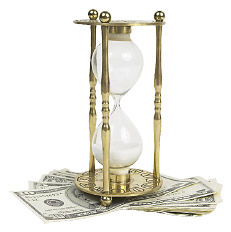APR and Fixed Rates

A Worked Example
This page provides an illustrative example of why an APR rate is usually much cheaper than a similar Fixed Rate.
Suppose you are looking for a 6 year loan of £1,000. One loan quotes you a flat rate of 5%, and the other an APR of 6%. Which is cheaper?
In fact, you can't compare these numbers: they are like blocks of chalk and cheese: they may look very similar at first, but are actually very different. Depending on the exact calculation, an Annual Percentage Rate of 6% will usually be much cheaper than a flat rate of 5%. This is because:
- the flat rate is applied to the whole of the loan every year
- the Annual Percentage Rate is calculated on the amount outstanding, which is reducing each year; because you are paying the loan back on a regular basis, the interest payment you make reduces.
The table below shows, roughly speaking, the interest payments you would make using the two different calculations. The table below
| Year | Fixed | APR |
| 1 | £50 | £60 |
| 2 | £50 | £50 |
| 3 | £50 | £40 |
| 4 | £50 | £30 |
| 5 | £50 | £20 |
| 6 | £50 | £10 |
| Total | £300 | £210 |
The above table is to illustrate the principle only; the calculations are not accurate and the actual amount payable using an APR of 6% would actually be much less than £210.
Nevertheless, you can see that the 'Fixed' calculation does exactly what it says: the interest is fixed for each year.
However, with the APR calculation the interest changes each year. It is worked out as a percentage of the amount you still owe. After the end of the first year you have paid some of the loan back, say approximately £140, so your loan has been reduced to £860. The interest calculation is therefore 6% of £860. Each year the amount of money you owe reduces, so you pay less and less interest.
Fixed monthly payments
Incidentally, you may wonder, in view of the explanation immediately above, why your monthly repayments don't reduce when interest is calculated using APR. This is because it is standard practice for lenders to keep your regular payments fixed, so that you can budget a regular amount and not have to pay more in the early years.
The lender does this with a clever calculation when working out how much of the loan you repay: the lender increases the amount you repay as you go through the loan. This compensates for your reducing interest rates. In the above APR example, your annual repayments, including interest and loan repayment, would be £201.66. Although the overall total stays the same, in later years your loan repayment increases whilst the interest payment reduces, as shown below:
| Year | Repayment | APR Interest | Total paid |
| 1 | £141.66 | £60 | £201.66 |
| 2 | £151.66 | £50 | £201.66 |
| 3 | £161.66 | £40 | £201.66 |
| 4 | £171.66 | £30 | £201.66 |
| 5 | £181.66 | £20 | £201.66 |
| 6 | £191.66 | £10 | £201.66 |
| Total | £1000 | £210 | £1210 |
Return to APR article
©2013 Team Technology. Privacy policy and cookies.

